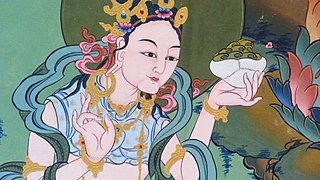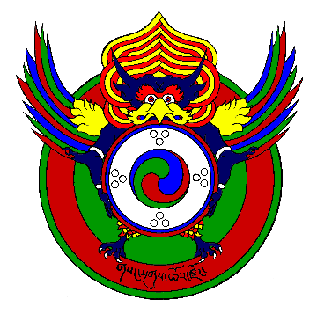Related Research Articles

Longchen Rabjam Drimé Özer, commonly abbreviated to Longchenpa was a Tibetan scholar-yogi of the Nyingma school of Tibetan Buddhism. According to tibetologist David Germano, Longchenpa's work led to the dominance of the Longchen Nyingthig lineage of Dzogchen over the other Dzogchen traditions. He is also responsible for the scholastic systematization of Dzogchen thought within the context of the wider Tibetan Vajrayana tradition of philosophy which was highly developed at the time among the Sarma schools. Germano also notes that Longchenpa's work is "generally taken to be the definitive expression of the Great Perfection with its precise terminological distinctions, systematic scope, and integration with the normative Buddhist scholasticism that became dominant in Tibet during the thirteenth and fourteenth centuries."

Dzogchen, also known as atiyoga, is a tradition of teachings in Indo-Tibetan Buddhism and Bon aimed at discovering and continuing in the ultimate ground of existence. The goal of Dzogchen is knowledge of this basis, this knowledge is called rigpa. There are spiritual practices taught in various Dzogchen systems for awakening rigpa.

Padmasambhava, also known as Guru Rinpoche and the Lotus from Oḍḍiyāna, was a tantric Buddhist Vajra master from medieval India who taught Vajrayana in Tibet. According to some early Tibetan sources like the Testament of Ba, he came to Tibet in the 8th century and helped construct Samye Monastery, the first Buddhist monastery in Tibet. He is thought to have been born in the Swat Valley in modern-day Pakistan, and to have foreseen the arrival of Ngawang Namgyal, the founder of Bhutan. However, little more is known about the actual historical figure other than his ties to Vajrayana and Indian Buddhism.

The Rimé movement is a movement or tendency in Tibetan Buddhism which promotes non-sectarianism and universalism. Teachers from all branches of Tibetan Buddhism – Sakya, Kagyu, Nyingma, Jonang, Gelug, and Bon – have been involved in the promoting Rimé ideals.

Nyingma, often referred to as Ngangyur, is the oldest of the four major schools of Tibetan Buddhism. The Nyingma school is founded on the first lineages and translations of Buddhist scriptures from Sanskrit into Tibetan in the eighth century, during the reign of King Trisong Detsen.

Jamgön Kongtrül Lodrö Thayé, also known as Jamgön Kongtrül the Great, was a Tibetan Buddhist scholar, poet, artist, physician, tertön and polymath. He is credited as one of the founders of the Rimé movement (non-sectarian), compiling what is known as the "Five Great Treasuries". He achieved great renown as a scholar and writer, especially among the Nyingma and Kagyu lineages and composed over 90 volumes of Buddhist writing, including his magnum opus, The Treasury of Knowledge.

Yeshe Tsogyal, also known as "Victorious Ocean of Knowledge", "Knowledge Lake Empress", or by her Sanskrit name Jñānasāgara "Knowledge Ocean", or by her clan name "Lady Kharchen", attained enlightenment in her lifetime and is considered the Mother of Tibetan Buddhism. Yeshe Tsogyal is the highest woman in the Nyingma Vajrayana lineage. Some sources say she, as Princess of Karchen, was either a wife or consort of Tri Songdetsen, emperor of Tibet, when she began studying Buddhism with Padmasambhava, who became her main karmamudrā consort. Padmasambhava is a founder-figure of the Nyingma tradition of Tibetan Buddhism, and is considered as a second buddha of our era. She is known to have revealed terma with Padmasambhava and was also the main scribe for these terma. Later, Yeshe Tsogyal also hid many of Padmasambhava's terma on her own, under the instructions of Padmasambhava for future generations.

Jigme Lingpa (1730–1798) was a Tibetan tertön of the Nyingma lineage of Tibetan Buddhism. He was the promulgator of the Longchen Nyingthig, the Heart Essence teachings of Longchenpa, from whom, according to tradition, he received a vision in which the teachings were revealed. The Longchen Nyingthik eventually became the most famous and widely practiced cycle of Dzogchen teachings.
In Tibetan Buddhism, Ngöndro refers to the preliminary, preparatory or foundational practices or disciplines common to all four schools of Tibetan Buddhism and also to Bon. They precede deity yoga.

Kyabje Dudjom Rinpoche Jigdral Yeshe Dorje was known simply as Dudjom Rinpoche. He is considered by many Tibetan Buddhists to be from an important Tulku lineage of Terton Dudul Dorje (1615-1672), and was recognized as the incarnation of Terton Dudjom Lingpa (1835-1904), a renowned treasure revealer. He was a direct incarnation of both Padmasambhava and Dudjom Lingpa. He was a Nyingma Householder, a yogi, and a Vajrayana and Dzogchen master. According to his secretary Khenpo Tsewang Dongyal and many others, he was revered as "His Holiness" (Kyabje) and as a "Master of Masters".
Semde (Tibetan: སེམས་སྡེ, Wylie: sems sde; Sanskrit: cittavarga, "mind division", "mind class" or "mind series" is the name of one of three scriptural and lineage divisions within the Dzogchen tradition. The Nyingma school of Tibetan Buddhism traditionally classifies its Dzogchen teaching into three main divisions: Semde, Longdé and Menngagde.
Mañjuśrīmitra was an Indian Buddhist scholar. He became the main student of Garab Dorje and a teacher of Dzogchen.

Rigdzin Kumaradza (1266–1343) was a Dzogchen master in the lineage of the Vima Nyingthig.
In Tibetan Buddhism and Bon, Menngagde, is the name of one of three scriptural and lineage divisions within Dzogchen.
In Dzogchen, rainbow body (Tibetan: འཇའ་ལུས་, Wylie: 'ja' lus, Jalü or Jalus) is a level of realization. This may or may not be accompanied by the 'rainbow body phenomenon'. The rainbow body phenomenon is pre-Buddhist in origin, and is a topic which has been treated fairly seriously in Tibet for centuries past and into the modern era. Other Vajrayana teachings also mention rainbow body phenomena which occurs during or after the death process.

The Aro gTér is a lineage within the Nyingma school of Tibetan Buddhism. The pure vision terma on which it is based teaches all Buddhist topics from the point of view of Dzogchen. The Aro gTer terma was received by Western-born Buddhist, Ngakpa Chögyam. The lineage is a ngagpa or non-monastic lineage and emphasizes householder practice and non-celibate ordination. All of its contemporary teachers are ethnically non-Tibetan.
Sri Singha was the teacher of Padmasambhava, Vimalamitra, and Vairotsana. He was a principal student and dharma-son of Mañjuśrīmitra in the Dzogchen lineage, and is credited by the Nyingma school with introducing Dzogchen to Tibet.
According to the Nyingmapa tradition of Tibetan Buddhism, the Dzogchen masters Manjushrimitra and Shrisimha were already active in the Tantric milieu in India independently. However, Manjushrimitra, a learned scholar of Brahman origin, was evidently an adherent of the Yogachara school before his becoming a disciple of the mysterious Prahevajra or Garab Dorje from the country of Uddiyana. It should also be recalled that his disciple Shrisimha was said to have born and resided for some time in China before coming to India. And that the latter's disciple Vimalamitra visited China before and after he came to Tibet and transmitted the Dzogchen teachings to his disciples at Samye Monastery.
Getse Mahapandita (1761–1829) was an important Nyingma scholar affiliated with Kathok Monastery.

The Seventeen Tantras of the Esoteric Instruction Series or the Seventeen Tantras of the Ancients are an important collection of tantras in the Nyingma school of Tibetan Buddhism. They comprise the core scriptures of the "esoteric instruction series" (Menngagde) of Dzogchen teachings and are its most authoritative scriptures.

The mind teachings of Tibet are a body of sacredly held instructions on the nature of mind and the practice of meditation on, or in accordance with, that nature. Although maintained and cultivated, to various degrees, within each of the major Tibetan Buddhist traditions, they are primarily associated with the mahamudra traditions of the Kagyu and the dzogchen traditions of the Nyingma.
References
- ↑ Snelling 2011, p. 66, 85.
- ↑ Cuevas, Bryan J. (Summer 1998). Book review The Sacred Life of Tibet, Tricycle: The Buddhist Review
- ↑ The Royal Geographic Society includes The Divine Madman in their recommended reading list for people visiting Bhutan
- ↑ see Dowman's article "Himalayan Intrigue: In Search of the New Karmapa", tricycle (Winter 1992)
- ↑ In his Foreword to Natural Perfection: Longchengpa's Radical Dzogchen Namkhai Norbu writes, "Kusho Keith Dowman, the translator of this text, has spent many years living in India and Nepal in communion with many great masters who have realized the Dzogchen view. Studying within their purview, fully immersed in the sacred teaching, he has fortuitously absorbed the realization of Dzogchen. Now he has translated this extraordinary text, The Treasury of Natural Perfection, and if it can become part of the lives of fortunate practitioners, its inestimable value will become immediately apparent."
- ↑ book review by Sheehy, Michael Ph.D (August 2013). , Buddhadharma: The Practitioner's Quarterly
- ↑ Finlayson, Iain (21 April 1984). "Cultural Cross-fertilisation". Glasgow Herald .